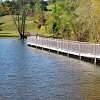
Stormwater Management on Construction Sites Package
-
Register
- Non member - $150
- Professional member - $100
- Professional Plus member - $100
- Professional Plus Org member - $100
- Student member - $100
- Young Professional member - $100
- Emeritus member - $100
- Discounted Professional member - $100
- Australia Member - $100
- Australia Non-Member - $150
Stormwater Management on Construction Sites Package
The primary stormwater pollutant at construction sites, is sediment. The management of stormwater on a construction site is important to stay in compliance! This package five (5) stormwater management courses will provide you the tools write, review and implement a stormwater pollution prevention plan, understand stormwater runoff, look at the sediment control process analytically, and put the best plan in place for your site.
On-Demand Courses:
- A Different Way of Looking at Sediment Control (2 PDH)
- How to Write and Implement a Stormwater Pollution Prevention Plan (3 PDH)
- Stormwater Management Pond Muck - Costly Waste or Valuable Resource? (1 PDH)
Course Level: Intermediate
$100 - IECA Members
$150 - Nonmembers
At the completion of all four (4) courses you will receive 7 Professional Development Hours of credit. For any questions on continuing education credit, please contact IECA Education at education@ieca.org
-
Contains 7 Component(s), Includes Credits
Have you found yourself struggling with designing or reviewing a SWPPP that really works? Have you been a part of a project in the past where the SWPPP was never properly implemented? If so, this course is for you.
Have you found yourself struggling with designing or reviewing a SWPPP that really works? Have you been a part of a project in the past where the SWPPP was never properly implemented? Then you understand already the need for a document which is field ready, and cohesive. The primary stormwater pollutant at construction sites, is sediment. To control and manage this pollutant, you need a good set of directions. These directions, are most effectively conveyed in a dynamic, well designed series of documents called a SWPPP (StormWater Pollution Prevention Plan). In order to design and develop a document like this effectively, it is important to follow some basic steps. In addition, it helps to further synthesize this development process with real – site specific complications. This design protocol makes your SWPPP unique and more effective than the typical “off the shelf templates” which haven’t been developed with a specific site and it’s dynamic conditions in mind. This course, when complete; will provide the user with a series of concrete steps to integrate within their next SWPPP design or SWPPP review. Whether you have never designed a SWPPP before, or done many – this course is for you.
Traditionally this industry has focused on documents for environmental compliance that do not appeal to the average professional on a construction site. The key strategy remains, “How does a professional designer create a SWPPP that is both environmentally compliant and gets properly installed during the project phases?” The fundamental steps in designing a SWPPP will follow the industry’s guidelines and integrate techniques that make the SWPPP useable on any construction project. By following a few critical steps, fundamental to success, the course participants will be exposed to key strategies and useful tips for designing a SWPPP that really works. Further, participants will learn to properly integrate practices, which will be emphasized along with cost comparisons for achieving environmentally compliant projects. If you design, inspect, install, or review Construction SWPPP Plans; then this course is for you.
- Module 1 brings the participant through a series of fundamental steps to begin SWPPP design. Often overlooked; these steps include site design, site assessment, and risk analysis. This step, if overlooked, can mean the difference between a good SWPPP and one which is never implemented.
- Module 2 resumes with typical grading practices. The course participants will learn about fundamental site access controls, perimeter management techniques and conclude with typical dewatering and slope protection analysis.
- Module 3 will highlight sediment management techniques involving channels and inlet devices. These steps along with previous modules allow the participant to effectively manage the whole project learning about dynamic changes and how to properly articulate them to the construction professional on site.
- Module 4 concludes the course with the often forgotten specific of risk analysis, documentation, permanent Stormwater practices, pollution prevention, and site signage. These steps, combined with previous modules best prepares the participant for the fundamentals behind a good SWPPP, able to be used on a site effectively.
Learning Objectives:
- Recognize the basic science of Erosion and Sedimentation, and the thought process behind design and implementation of a proper SWPPP
- Use Best Management Practices for SWPPP Development and Construction Site Erosion and Sediment Control Implementation
- Develop an understanding of stormwater runoff management and erosion and sediment control Best Management Practices
- Demonstrate and understanding of Best Management Practices and the processes of erosion and sedimentation
- Apply the understanding of risk analysis and site assessment to the development of a site specific SWPPP
Course Level: Intermediate

Jennifer Hildebrand, , CPESC,CPSWQ, CESSWI, CISEC
Jennifer Hildebrand, CPESC, CPSWQ, CESSWI, CISEC has been involved in the erosion and sediment industry for over 18 years. She has a master’s degree in Business Administration from Augsburg College, and specializes in compliance strategies within the stormwater market. She is a registered Certified Professional in Erosion and Sediment Control and a registered Certified Professional in Stormwater Quality. She is a registered Certified Erosion, Sediment, and Stormwater Inspector. She is also a Certified Inspector for Sediment and Erosion Control. Currently employed by Weis Builders, Jennifer's experience and industry involvement allow WSB to deliver excellence in environmental compliance to their clients. Her specialties include stormwater compliance issues, training and awareness programs, site inspection programs, compliance program design, and site plan reviews. She has developed and delivered education and compliance programs in both the construction and post construction stormwater market. Her involvement in the construction industry has provided her with valuable experience in a wide variety of stormwater compliance products and services. As a result, Jennifer has developed a selection of technologies that involve several methods of hydraulic application techniques and biotechnical stabilization practices throughout the United States and Canada. This private industry experience and public representation experience provides opportunities for facilitation of appropriate stormwater, erosion, sediment, control programs and techniques. In addition, this experience also illuminates the challenges and opportunities that exist in post construction phases of stormwater compliance. Jennifer has gained valuable insight into the realities of land development, commerce, and environmental impacts in the stormwater industry as a result of her involvement with these non-profit entities, as well as the private sector of this business. Among these organizations she has given numerous presentations on proper management practices, installation techniques, full day programs on erosion and sediment control practices, along with numerous product specific presentations. Her presentations and classes have been conducted in Minnesota, North Dakota, South Dakota, Illinois, Wisconsin, Idaho, Indiana, Michigan, Tennessee, and New Mexico.
At the completion of this course you will receive 3 Professional Development Hour of credit. For any questions on continuing education credit, please contact IECA Education at education@ieca.org
-
Contains 5 Component(s), Includes Credits
This course discusses the effects of stormwater runoff volume and rates on the performance of temporary sediment control BMPs on construction site.
Has your BMP failed and you don’t know why? Do you feel like you are checking off the BMP box without a full grasp of the science behind the BMP placement? This course discusses the effects of stormwater runoff volume and rates on the performance of temporary sediment control BMPs on construction site. Many times, it is determined that the BMP was the cause of a failure. In reality, the BMP failure was caused by stormwater runoff in excess of the BMPs capacity, this failure could have been identified during the design process. This course will look at topography, soil type and geographic location and how you can use this information to predict the effectiveness of design for your construction site.

Course Level: Intermediate

Thomas W. Schneider, CPESC
As Head of Storm Water Compliance at Stormcon, L.L.C., Tom Schneider brings 28 years of experience and extensive training in storm water regulations focusing on construction site erosion and sediment control. Mr. Schneider works directly with local, state, and federal agencies as well as working one on one with clients to develop and implement storm water programs that will fit their needs. In the past, Mr. Schneider has been invited to testify in front of congressional subcommittees in regard to NPDES issues.
At the completion of this course you will receive 2 Professional Development Hours of credit. For any questions on continuing education credit, please contact IECA Education at education@ieca.org
-
Contains 4 Component(s), Includes Credits
SWM ponds require routine sediment removal in order to maintain stormwater quality and quantity control.
SWM ponds require routine sediment removal in order to maintain stormwater quality and quantity control. Sediments typically contain common urban contaminants (e.g. petroleum hydrocarbons (PHCs), polyaromatic hydrocarbons (PAHs), road salt, etc.) which trigger non-hazardous waste disposal requirements. Landfill tipping fees can amount to hundreds of thousands to millions of dollars per pond. This webinar presents two recent sediment beneficial use case studies. These studies demonstrate how ecotoxicity tests and risks assessments allowed the sediments to be used as topsoil amendments as cost effective and environmentally sustainable alternatives to landfill disposal. These studies set the precedent for future SWM pond sediment beneficial use projects as well.

Learning Objectives:
- Understanding SWM pond sediment chemistry
- Understanding the disposal versus beneficial use evaluation process
- Lessons learned from the first 2 SWM pond sediment beneficial use projects in Canada
Course Level: All

Francine Kelly-Hooper, Ph.D.
Dr. Francine Kelly-Hooper is a Senior Soils Scientist with over 20 years of experience in the government and private consulting sectors. Francine operated her research based consulting firm, Kelly Hooper Environmental, for 16 years before joining CH2M HILL in 2014. She is now an Environmental Contaminant Scientist at Stantec Consulting. Francine completed her PhD at the University of Waterloo in 2013, where she developed a new method for identifying petroleum hydrocarbon sources in soils and sediments. Over the past 18 years, she has compiled sediment chemistry profiles for 120 SWM ponds. Francine and her team continue to work with municipalities and governments on the development of a new approach to SWM sediment beneficial use evaluations.





